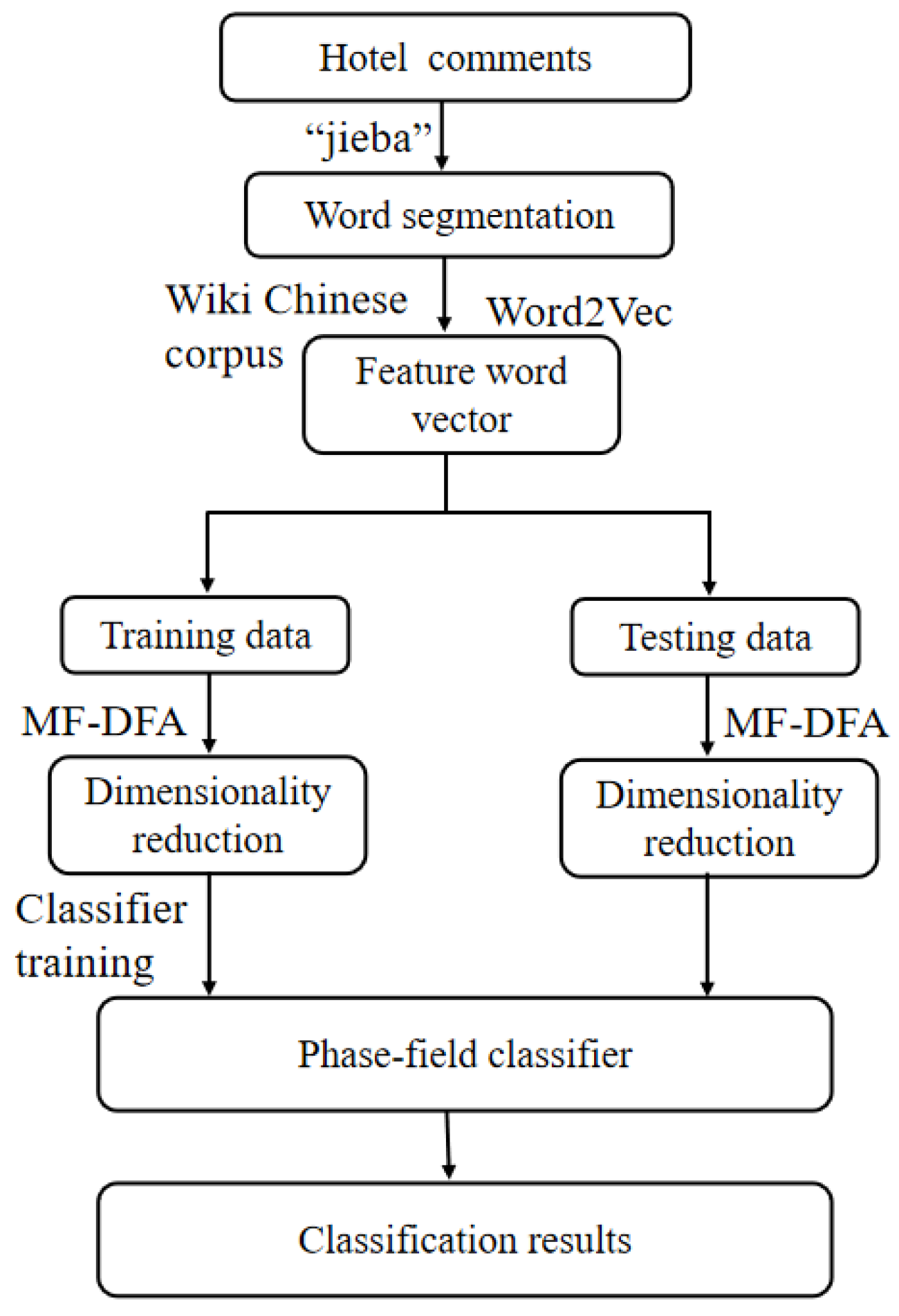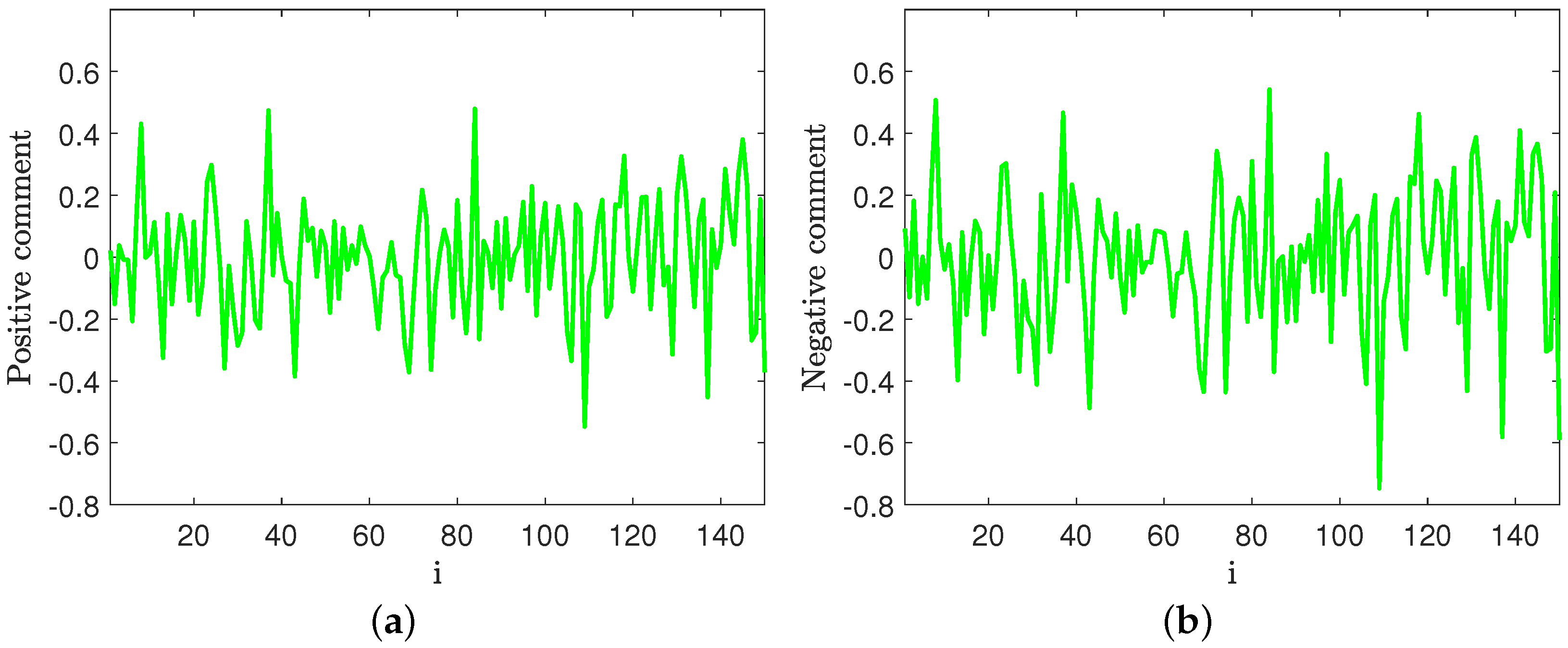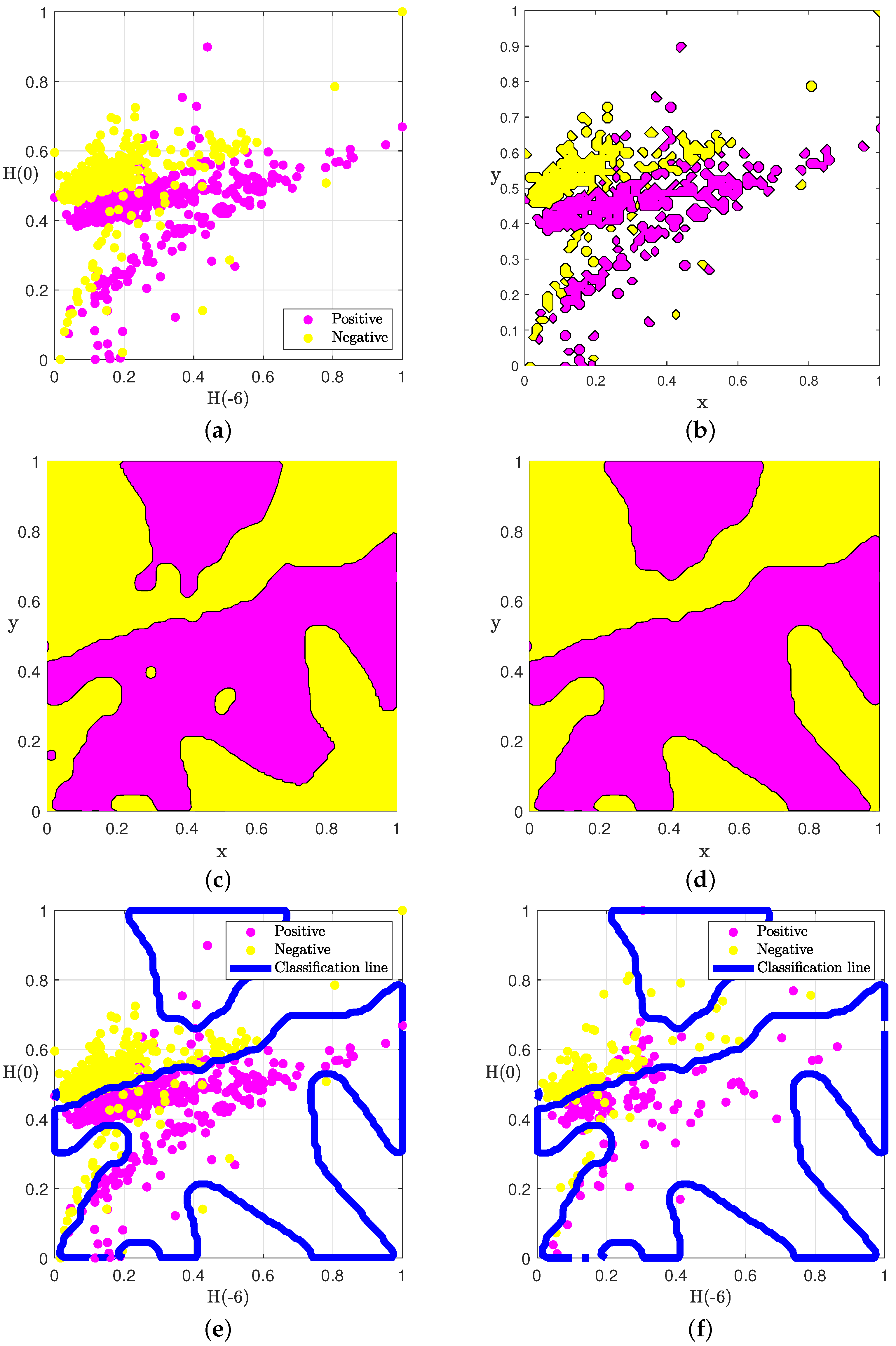Hotel Comment Emotion Classification Based on the MF-DFA and Partial Differential Equation Classifier
Abstract
:1. Introduction
2. Methodology
2.1. MF-DFA
2.2. Phase-Field Model
3. Data Collection
4. Experimental Results
- I.
- If an instance is positive and predicted to be positive, it is the true class TP (True Positive);
- II.
- If an instance is positive but predicted to be negative, it is called a false negative class FN (False Negative);
- III.
- If an instance is negative but predicted to be positive, it is a false positive FP (False Positive);
- IV.
- If an instance is negative and predicted to be negative, it is true negative class TN (True Negative).
5. Conclusions
Author Contributions
Funding
Data Availability Statement
Acknowledgments
Conflicts of Interest
References
- Hirschberg, J.; Manning, C.D. Advances in natural language processing. Science 2015, 349, 261–266. [Google Scholar] [CrossRef] [PubMed]
- Lu, Y. Artificial intelligence: A survey on evolution, models, applications and future trends. J. Manag. Anal. 2019, 6, 1–29. [Google Scholar] [CrossRef]
- Hu, M.; Dang, C.; Chintagunta, P.K. Search and learning at a daily deals website. Mark. Sci. 2019, 38, 609–642. [Google Scholar] [CrossRef]
- Bansal, N.; Sharma, A.; Singh, R.K. Fuzzy AHP approach for legal judgement summarization. J. Manag. Anal. 2019, 6, 323–340. [Google Scholar] [CrossRef]
- He, W.; Tian, X.; Tao, R.; Zhang, W.; Yan, G.; Akula, V. Application of social media analytics: A case of analyzing online hotel reviews. Online Inf. Rev. 2017, 41, 921–935. [Google Scholar] [CrossRef]
- Gaur, L.; Afaq, A.; Solanki, A.; Singh, G.; Sharma, S.; Jhanjhi, N.Z.; My, H.T.; Le, D.N. Capitalizing on big data and revolutionary 5G technology: Extracting and visualizing ratings and reviews of global chain hotels. Comput. Electr. Eng. 2021, 95, 107374. [Google Scholar] [CrossRef]
- Kang, Y.; Cai, Z.; Tan, C.W.; Huang, Q.; Liu, H. Natural language processing (NLP) in management research: A literature review. J. Manag. Anal. 2020, 7, 139–172. [Google Scholar] [CrossRef]
- Alshemali, B.; Kalita, J. Improving the reliability of deep neural networks in NLP: A review. Knowl.-Based Syst. 2020, 191, 105210. [Google Scholar] [CrossRef]
- Sann, R.; Lai, P.C. Understanding homophily of service failure within the hotel guest cycle: Applying NLP-aspect-based sentiment analysis to the hospitality industry. Int. J. Hosp. Manag. 2020, 91, 102678. [Google Scholar] [CrossRef]
- Jiao, Y.; Qu, Q.X. A proposal for Kansei knowledge extraction method based on natural language processing technology and online product reviews. Comput. Ind. 2019, 108, 1–11. [Google Scholar] [CrossRef]
- Sharma, M.; Singh, G.; Singh, R. Design of GA and ontology based NLP frameworks for online opinion mining. Recent Patents Eng. 2019, 13, 159–165. [Google Scholar] [CrossRef]
- Guerrero-Rodriguez, R.; Álvarez-Carmona, M.Á.; Aranda, R.; López-Monroy, A.P. Studying online travel reviews related to tourist attractions using nlp methods: The case of guanajuato, mexico. Curr. Issues Tour. 2023, 26, 289–304. [Google Scholar] [CrossRef]
- Wang, X.; Xu, Z.; Gou, X. The Interval probabilistic double hierarchy linguistic EDAS method based on natural language processing basic techniques and its application to hotel online reviews. Int. J. Mach. Learn. Cybern. 2022, 13, 1517–1534. [Google Scholar] [CrossRef]
- Cai, W.; Mohammaditab, R.; Fathi, G.; Wakil, K.; Ebadi, A.G.; Ghadimi, N. Optimal bidding and offering strategies of compressed air energy storage: A hybrid robust-stochastic approach. Renew. Energy 2019, 143, 1–8. [Google Scholar] [CrossRef]
- Saeedi, M.; Moradi, M.; Hosseini, M.; Emamifar, A.; Ghadimi, N. Robust optimization based optimal chiller loading under cooling demand uncertainty. Appl. Therm. Eng. 2019, 148, 1081–1091. [Google Scholar] [CrossRef]
- Liu, J.; Chen, C.; Liu, Z.; Jermsittiparsert, K.; Ghadimi, N. An IGDT-based risk-involved optimal bidding strategy for hydrogen storage-based intelligent parking lot of electric vehicles. J. Energy Storage 2020, 27, 101057. [Google Scholar] [CrossRef]
- Mehrpooya, M.; Ghadimi, N.; Marefati, M.; Ghorbanian, S.A. Numerical investigation of a new combined energy system includes parabolic dish solar collector, Stirling engine and thermoelectric device. Int. J. Energy Res. 2021, 45, 16436–16455. [Google Scholar] [CrossRef]
- Jiang, W.; Wang, X.; Huang, H.; Zhang, D.; Ghadimi, N. Optimal economic scheduling of microgrids considering renewable energy sources based on energy hub model using demand response and improved water wave optimization algorithm. J. Energy Storage 2022, 55, 105311. [Google Scholar] [CrossRef]
- Han, E.; Ghadimi, N. Model identification of proton-exchange membrane fuel cells based on a hybrid convolutional neural network and extreme learning machine optimized by improved honey badger algorithm. Sustain. Energy Technol. Assess. 2022, 52, 102005. [Google Scholar] [CrossRef]
- Jiang, Z.Q.; Xie, W.J.; Zhou, W.X.; Sornette, D. Multifractal analysis of financial markets: A review. Rep. Prog. Phys. 2019, 82, 125901. [Google Scholar] [CrossRef]
- Fernandes, L.H.; Silva, J.W.; de Araujo, F.H.; Tabak, B.M. Multifractal cross-correlations between green bonds and financial assets. Financ. Res. Lett. 2023, 53, 103603. [Google Scholar] [CrossRef]
- Yao, C.Z.; Liu, C.; Ju, W.J. Multifractal analysis of the WTI crude oil market, US stock market and EPU. Phys. A Stat. Mech. Its Appl. 2020, 550, 124096. [Google Scholar] [CrossRef]
- Mensi, W.; Vo, X.V.; Kang, S.H. Upward/downward multifractality and efficiency in metals futures markets: The impacts of financial and oil crises. Resour. Policy 2022, 76, 102645. [Google Scholar] [CrossRef]
- Li, N.; Wu, S.B.; Yu, Z.H.; Gong, X.Y. Feature Extraction with Multi-fractal Spectrum for Coal and Gangue Recognition Based on Texture Energy Field. Nat. Resour. Res. 2023, 32, 2179–2195. [Google Scholar] [CrossRef]
- Joseph, A.J.; Pournami, P.N. Multifractal theory based breast tissue characterization for early detection of breast cancer. Chaos Solitons Fractals 2021, 152, 111301. [Google Scholar] [CrossRef]
- Lahmiri, S.; Bekiros, S. Complexity measures of high oscillations in phonocardiogram as biomarkers to distinguish between normal heart sound and pathological murmur. Chaos Solitons Fractals 2022, 154, 111610. [Google Scholar] [CrossRef]
- Abbasi, M.U.; Rashad, A.; Basalamah, A.; Tariq, M. Detection of epilepsy seizures in neo-natal EEG using LSTM architecture. IEEE Access 2019, 7, 179074–179085. [Google Scholar] [CrossRef]
- Allen, S.M.; Cahn, J.W. A microscopic theory for antiphase boundary motion and its application to antiphase domain coarsening. Acta Metall. 1979, 27, 1085–1095. [Google Scholar] [CrossRef]
- Liu, C.; Qiao, Z.; Zhang, Q. Multi-phase image segmentation by the Allen–Cahn Chan–Vese model. Comput. Math. Appl. 2023, 141, 207–220. [Google Scholar] [CrossRef]
- Han, Z.; Xu, H.; Wang, J. A simple shape transformation method based on phase-field model. Comput. Math. Appl. 2023, 147, 121–129. [Google Scholar] [CrossRef]
- Wang, J.; Han, Z.; Jiang, W.; Kim, J. A fast, efficient, and explicit phase-field model for 3D mesh denoising. Appl. Math. Comput. 2023, 458, 128239. [Google Scholar] [CrossRef]
- Li, Y.; Song, X.; Kwak, S.; Kim, J. Weighted 3D volume reconstruction from series of slice data using a modified Allen–Cahn equation. Pattern Recognit. 2022, 132, 108914. [Google Scholar] [CrossRef]
- Liu, C.; Qiao, Z.; Zhang, Q. Two-Phase Segmentation for Intensity Inhomogeneous Images by the Allen–Cahn Local Binary Fitting Model. SIAM J. Sci. Comput. 2022, 44, B177–B196. [Google Scholar] [CrossRef]
- Park, J.; Lee, C.; Choi, Y.; Lee, H.G.; Kwak, S.; Hwang, Y.; Kim, J. An unconditionally stable splitting method for the Allen–Cahn equation with logarithmic free energy. J. Eng. Math. 2022, 132, 18. [Google Scholar] [CrossRef]
- Choi, Y.; Kim, J. Maximum principle preserving and unconditionally stable scheme for a conservative Allen–Cahn equation. Eng. Anal. Bound. Elem. 2023, 150, 111–119. [Google Scholar] [CrossRef]
- Zhang, B.; Yang, Y. A new linearized maximum principle preserving and energy stability scheme for the space fractional Allen–Cahn equation. Numer. Algorithms 2023, 93, 179–202. [Google Scholar] [CrossRef]
- Wang, J.; Han, Z.; Jiang, W.; Kim, J. A novel classification method combining Phase-Field and DNN. Pattern Recognit. 2023, 142, 109723. [Google Scholar] [CrossRef]
- Wang, J.; Xu, H.; Jiang, W.; Han, Z.; Kim, J. A novel MF-DFA-Phase-Field hybrid MRIs classification system. Expert Syst. Appl. 2023, 225, 120071. [Google Scholar] [CrossRef]
- Miloş, L.R.; Haţiegan, C.; Miloş, M.C.; Barna, F.M.; Boțoc, C. Multifractal detrended fluctuation analysis (MF-DFA) of stock market indexes. Empirical evidence from seven central and eastern European markets. Sustainability 2020, 12, 535. [Google Scholar] [CrossRef]
- Aslam, F.; Aziz, S.; Nguyen, D.K.; Mughal, K.S.; Khan, M. On the efficiency of foreign exchange markets in times of the COVID-19 pandemic. Technol. Forecast. Soc. Chang. 2020, 161, 120261. [Google Scholar] [CrossRef]
- Wang, J.; Shao, W.; Kim, J. Ecg classification comparison between mf-dfa and mf-dxa. Fractals 2021, 29, 2150029. [Google Scholar] [CrossRef]
- Wang, F.; Wang, H.; Zhou, X.; Fu, R. Study on the effect of judgment excitation mode to relieve driving fatigue based on MF-DFA. Brain Sci. 2022, 12, 1199. [Google Scholar] [CrossRef] [PubMed]
- Thomas, J.W. Numerical Partial Differential Equations: Finite Difference Methods; Springer Science & Business Media: New York, NY, USA, 2013; Volume 22. [Google Scholar]
- Tan, S.; Zhang, J. An empirical study of sentiment analysis for Chinese documents. Expert Syst. Appl. 2008, 34, 2622–2629. [Google Scholar] [CrossRef]





| Group | TP | TN | FP | FN | Accuracy | Precision | Recall | |
|---|---|---|---|---|---|---|---|---|
| & | 115 | 149 | 10 | 26 | 0.88 | 0.92 | 0.82 | 0.87 |
| & | 118 | 145 | 14 | 23 | 0.88 | 0.89 | 0.84 | 0.86 |
| & | 120 | 146 | 13 | 21 | 0.89 | 0.90 | 0.85 | 0.87 |
| Method | Accuracy | Precision | Recall | |
|---|---|---|---|---|
| DNN | 0.80 | 0.79 | 0.77 | 0.78 |
| SVM | 0.82 | 0.83 | 0.79 | 0.81 |
| Ours | 0.89 | 0.90 | 0.85 | 0.87 |
Disclaimer/Publisher’s Note: The statements, opinions and data contained in all publications are solely those of the individual author(s) and contributor(s) and not of MDPI and/or the editor(s). MDPI and/or the editor(s) disclaim responsibility for any injury to people or property resulting from any ideas, methods, instructions or products referred to in the content. |
© 2023 by the authors. Licensee MDPI, Basel, Switzerland. This article is an open access article distributed under the terms and conditions of the Creative Commons Attribution (CC BY) license (https://creativecommons.org/licenses/by/4.0/).
Share and Cite
Duanzhu, S.; Wang, J.; Jia, C. Hotel Comment Emotion Classification Based on the MF-DFA and Partial Differential Equation Classifier. Fractal Fract. 2023, 7, 744. https://doi.org/10.3390/fractalfract7100744
Duanzhu S, Wang J, Jia C. Hotel Comment Emotion Classification Based on the MF-DFA and Partial Differential Equation Classifier. Fractal and Fractional. 2023; 7(10):744. https://doi.org/10.3390/fractalfract7100744
Chicago/Turabian StyleDuanzhu, Sangjie, Jian Wang, and Cairang Jia. 2023. "Hotel Comment Emotion Classification Based on the MF-DFA and Partial Differential Equation Classifier" Fractal and Fractional 7, no. 10: 744. https://doi.org/10.3390/fractalfract7100744
APA StyleDuanzhu, S., Wang, J., & Jia, C. (2023). Hotel Comment Emotion Classification Based on the MF-DFA and Partial Differential Equation Classifier. Fractal and Fractional, 7(10), 744. https://doi.org/10.3390/fractalfract7100744







